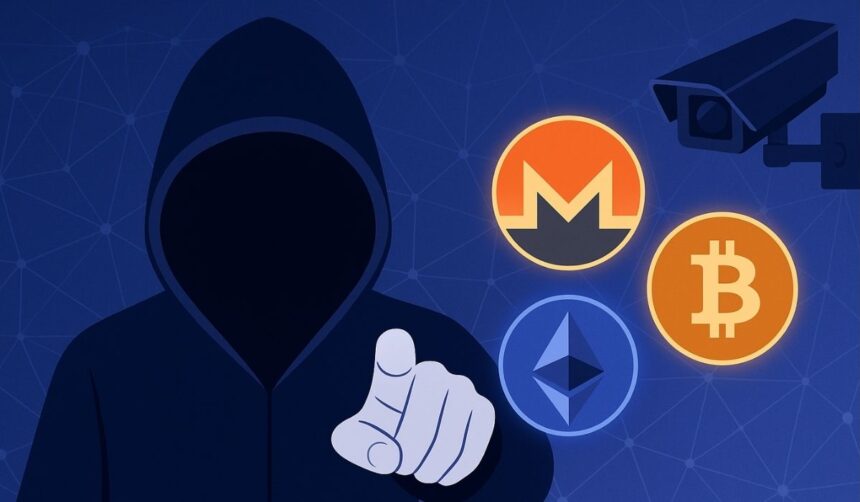In 2025, the idea of trading cryptocurrencies anonymously is still alive, but not in the way it used to be. With tighter rules, better surveillance tools, and fewer loopholes, staying private while handling crypto has become… well, trickier.
That doesn’t mean people gave up. Not at all. If anything, the desire for anonymity has only grown. But what’s changed is how folks go about it. The methods evolved. The tools matured. And the reasons? Those run deeper than most people think.
Anonymous trading today isn’t about avoiding rules, it’s more about having control. Keeping your financial movements disconnected from your real identity has gone from niche to necessary, especially as privacy continues to erode online. Doesn’t matter if it’s a small swap or some cross-chain juggling, staying under the radar still works, just takes more effort now than before.
Why People Still Want to Trade in the Dark
Different people, different reasons. The motivations behind private trading are wide-ranging, and honestly? They’re often far from what people assume. Here’s why users are still opting for anonymity in the crypto space:
- Digital Privacy: People are tired of being tracked. Every click, every login – recorded. Anonymous trading offers a way to sidestep that constant observation.
- Security: When your wallet is tied to your identity, you’re a bigger target. Phishing, hacks, even physical threats, some just don’t want the exposure.
- Discretion: Maybe it’s family, maybe it’s coworkers. Not everyone wants their portfolio size or token choices to be public knowledge.
- Regulatory Restrictions: In places where crypto is limited or outright banned, privacy isn’t optional, it’s survival.
- Philosophical Belief: Some traders believe financial privacy is a right, not a luxury. They see anonymity as central to what crypto is supposed to be.
- KYC Fatigue: After repeated leaks and hacks, trust in centralized exchanges isn’t what it once was. Many just don’t want to hand over IDs anymore.
- Testing in Stealth: Traders often want to experiment without revealing strategies linked to their main accounts.
Whatever the motive, the need is real, and growing.
What Anonymous Crypto Trading Looks Like in 2025
Anonymous trading doesn’t mean what it used to. It’s no longer just about obscure tools or hoping for the best. It has structure now; steps, preferences, methods. Here’s what that landscape looks like today.
Decentralized Exchanges (DEXs)
DEXs are still the go-to for anonymous traders. No sign-ups, no ID forms, just plug in your wallet and go. While some of these platforms have limited features compared to their centralized cousins, others are catching up fast. The trick is picking one that doesn’t log your data or track user activity through the frontend.
Privacy Coins and Shielded Transactions
Monero, Zcash, and similar tokens offer built-in privacy tech. These assets don’t just mask who’s sending what, they scramble the whole trail. In most cases, it’s difficult to link a transaction to a person unless they reveal it themselves. However, not all platforms support these coins, and converting them without revealing identity requires a careful approach.
Coin Mixers and Anonymity Pools
Some users still rely on coin mixers or pooling services to cover their trails. These services blend funds from multiple wallets and redistribute them in ways that confuse on-chain tracking. They work, but they’re under scrutiny in many countries. Plus, not all mixers are safe, some have vanished with user funds. It’s a grey area.
VPNs, Private Browsers, and Burner Wallets
It’s not just about where you trade, it’s also about how. VPNs and privacy-focused browsers like Tor help mask your IP, while burner wallets allow one-time usage with no trace. Stack these together, and you’ve got a decent shield. It’s not perfect, but it adds distance.
Some traders also opt for platforms that don’t require identification at all. These No KYC crypto exchanges allow you to trade without paperwork, and they’ve quietly become a haven for privacy-minded users, especially those who care about speed, access, and keeping their holdings under wraps.
How the Platforms Have Grown Up
It wasn’t always this polished. A few years ago, anonymous platforms felt like risky side quests. Basic interfaces, slow swaps, sketchy contracts, you had to be a techie or a gambler to even try.
That’s changed.
Now, many of these platforms go through regular code audits. Their smart contracts are reviewed, often by third-party firms, and bugs are patched quickly. Some rely on multi-signature wallets and DAO-controlled treasuries, spreading control out and reducing single points of failure. Others have begun to isolate front-end scripts and avoid collecting user metadata entirely.
It’s less cowboy, more calculated now. Privacy doesn’t mean unsafe anymore, it just means users have to take responsibility for their own moves.
The Features Are More Than Just a Simple Swap
Trading anonymously no longer feels like you’re settling for less. Today, platforms are offering more depth than ever, quietly competing with traditional exchanges without demanding your identity.
There’s multi-chain access, routing tools, gas fee optimization, bridges between privacy coins and stablecoins, and even access to leverage or staking, without tying wallets to centralized servers. Some interfaces now include basic analytics, wallet trackers, and trade summaries that run locally on your browser, not stored on any server.
Anonymous trading has developed into a well-equipped corner of the crypto space, not a stripped-down backup plan.
But It’s Not Without Its Landmines
Anonymous crypto trading isn’t risk-free, and anyone considering it should be clear-eyed about what it involves.
First, there’s the lack of support. If you make an error, wrong address, failed transaction, there’s often no recovery process. Many privacy-oriented platforms don’t have customer service or dispute resolution. You’re responsible for everything from security to troubleshooting.
Then there’s the legal gray area. Some tools used for anonymous trading are banned or under regulatory watch in several countries. The frameworks change fast, and what might seem acceptable now could fall under scrutiny later. Navigating that isn’t easy, especially for users in jurisdictions with strict compliance laws.
And scams? They’re a real concern. The absence of identity checks means bad actors operate with fewer barriers. If something goes wrong, there’s usually no one to hold accountable.
Anonymous trading removes layers of friction, but also removes layers of protection. That’s the balance users have to weigh carefully.
Final Thoughts: Privacy Isn’t Gone, But It’s More Complex
The option to trade cryptocurrencies anonymously hasn’t disappeared. It’s still possible, but it’s no longer simple. What used to be a workaround is now a well-organized process that demands technical awareness, legal caution, and personal responsibility.
Some will find the effort worth it. Others might decide the risks outweigh the benefits. Either way, the tools are still here, and they continue to evolve. Whether you’re stepping into this space for privacy, strategy, or necessity, know that every step leaves a mark, even when no name is attached.















